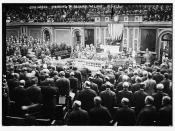Representative democracy is a political system in which the leaders and representatives acquire political power by means of a competitive struggle for the people's vote. A country with representative democracy is the United States of America. There are two central issues concerning the nature of representation. The first issue is does a representative have to share the demographic characteristics of the majority of the constituency? The other issue is should a representative follow his conscience or should a representative follow the majority will of the constituency? In answering the first question, we must understand the two conceptions of representation: descriptive and substantive. Descriptive representation is the statistical correspondence of the demographic characteristics of representatives with those of their constituents. They believed that citizens of a racial or ethnic background should be represented by persons of the same background. Substantive representation is the correspondence between representative's opinions and those of their constituents.
They believed that it does not matter if a representative comes from the same background of their constituents as long as he or she represents their opinions.
Melancton Smith, an Antifederalist, supported descriptive representation in a speech at Poughkeepsie Convention on June 21, 1788. He believed that the knowledge necessary for a representative to seek the true interests of the people is not only the comprehension of political and commercial information but is also the comprehension of the kind of acquaintance with the common concerns and occupations of the people. Smith argued that a representative couldn't understand his or her constituent unless he is part of them. One must understand the nature, circumstances and ability of the people in order to represent their true interests.
Alexander Hamilton, a Federalist, supported substantive representation in Federalist 35. In this paper, he used an example of manufactures and merchants to illustrate...


